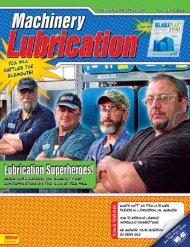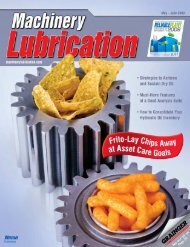Machinery Lubrication July August 2008
Machinery Lubrication July August 2008
Machinery Lubrication July August 2008
You also want an ePaper? Increase the reach of your titles
YUMPU automatically turns print PDFs into web optimized ePapers that Google loves.
There is another solution: New additive technology for<br />
hydraulic oil can reduce the need to frequently clean or<br />
change the servo valves. Such technology works to prevent<br />
varnish from depositing on critical work surfaces. The result<br />
is longer component life and a hydraulic system that stays<br />
clean. That translates into improved equipment efficiency<br />
and reduced cost.<br />
A major use for industrial lubricants is in hydraulic equipment,<br />
and varnish formation is a major issue<br />
for many of these applications.<br />
is most obvious at low pressures when there is little<br />
centrifugal force and low fluid pressure.<br />
In the case of piston pumps, varnish can increase piston<br />
land friction against the wear plate, leading to leakage and<br />
possible seizure. It also is well known that sticking valves,<br />
such as the regulation valves on piston pumps, can cause<br />
unscheduled stoppages during equipment use. Finally, the<br />
varnish that forms can block filters, leading to high use of<br />
Varnish Defined<br />
As oil ages, it degrades through oxidation<br />
and thermal decomposition. The additives,<br />
which are performance-enhancing chemicals,<br />
are consumed during the life of the<br />
fluid. The decomposition by-products of<br />
aging increase over the life of the oil, ultimately<br />
forming varnish.<br />
Because varnish is polar, it is attracted to<br />
metal surfaces, including servo valves. It<br />
starts as a sticky, soft residue and attracts<br />
wear debris, forming a sandpaper-like<br />
surface. In time, it ends up as a tenacious,<br />
hard lacquer.<br />
Why It’s Bad<br />
Oil that has oxidized generally does not<br />
lubricate well. It can reduce oil flow, plug<br />
filters, cause valves (especially proportional<br />
and servo types) to stick, increase friction,<br />
inhibit heat transfer and elevate operating<br />
temperature. Because varnish acts as an<br />
insulator, cooling capacity can be diminished.<br />
In addition, oxidation shortens<br />
component life, affecting valves, filters,<br />
pumps, bearings and seals. The result is<br />
diminished hydraulic system performance.<br />
For example, when varnish adheres to<br />
vanes in high-performance vane pumps, the<br />
vanes can stick in the rotor slot. This can<br />
result in increased noise, decreased volumetric<br />
and mechanical efficiency with an<br />
equivalent increase in energy consumption,<br />
side plate scuffing, rotary seal damage and<br />
possibly bearing damage. The phenomenon<br />
<strong>Machinery</strong> <strong>Lubrication</strong> machinerylubrication.com <strong>July</strong> - <strong>August</strong> <strong>2008</strong> 19
















